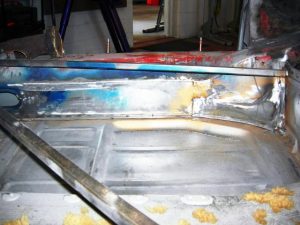Floor Pans
by Ryan Kenton
When restoring classic cars, the topic usually begins with the floor pans. You’ve probably viewed pictures and/or commentary in an automotive publication a million times. For sale ads that say “solid floors” or “floors are good”. These descriptions are meant to persuade the potential buyer that the project is a good investment. Floors keep the car solid and are integral to its foundation. Solid floors are essential in the multi stage process of a proper classic car restoration.
There are numerous examples of supposedly completed repairs, that do not help the overall condition, and can actually degrade the structural integrity. The following pictures provide an example of a project car with questionable metal fabrication that was allegedly finished with “solid floors”, and why we chose to redo the work.

Picture 1: What you’re looking at in this photo, is a floor pan and an inside rocker panel. Both appear to have patchwork completed; and although there’s no visible signs of rust, there may be other equally devastating issues going on within these layers of formed steel components.

Picture 2: To look more closely at the seams, all of the welds have been made poorly and left unfinished. Note that the welds were done very liberally. This gives us hints that the repairs may have been hastily completed without much forethought about this critical aspect of the project. Someone decided this car needed rust holes patched, and had a free for all with the welder causing more issues.

Picture 3: You can see that repairs have been made, but structural help was still required. The large kinks in the rocker show this car had major damage and was simply welded together without being straightened. This will lead to a car that may be solid – but not straight and aligned. Fitting doors and fenders on this car would surely prove to be a task! This is a perfect example of a process that short cuts quality workmanship.

Picture 4: This is a picture of a comparable car completed in our shop that has been properly repaired, and how it contrasts with the previous photo(number three). First you’ll notice large bracing that has kept the car structurally aligned while the floors were cut out. There are no kinks or damage to the rocker panel. There are no large amounts of weld simply “gluing” this car together. All welds are strategically duplicated at factory locations for an original, untampered appearance. The welds have also been finished and smoothed for proper paint adherence. The bracing will be cut out, and this car will appear the same as when it rolled off the assembly line.
In Conclusion: Cars can be repaired by anyone, but there are significant differences between attempting to quickly piece parts together, and owning a car with a proper and professional level of restoration. The above floor repairs were not solid, and would have been an accident waiting to happen. Surely, the car projects above that were brought into our shop had floor and rocker panels that were welded in. However, the ill-thought repairs would lead to a multitude of future headaches if we did not take corrective action. Identifying visible problems before matters get worse, will save time and money tenfold. Don’t be afraid to own a project car, just make sure those tasked with this critical stage do not make matters worse with an improper quick fix.
